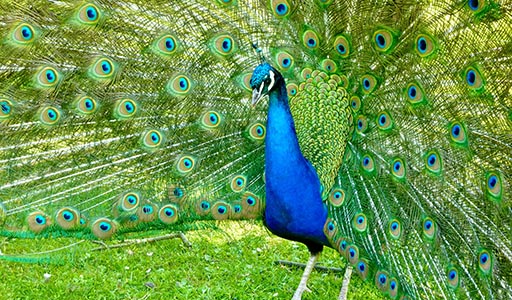Peacocks

Peacock Information
Peacocks are known for their brightly feathered tails. Peacocks feed off of plants and insects that they find on the ground. Most peacocks are native to Southeast Asia and were likely brought to the United States as early as the 19 century. However, there is a growing population of peacocks across many parts of Florida. Once a few peacocks have escaped from captivity, they can repopulate quickly, creating a peafowl epidemic.

What does a Peacock look like?
Peacocks are best known for their vivid plumage. Male peacocks have bright blue heads and necks, as well as tails of long, iridescent green, blue, and gold feathers with distinctive, eye-shaped tips. These feathers can either lay flat across their backs or be raised in a fan for courtship rituals. On the other hand, the much smaller females, or peahens, need to hide from predators rather than attract mates, so their plumage is a dull, mottled brown. Peacocks have strong, long legs with sharp spurs that allow them to run quickly and defend themselves.

What does a Peacock eat?
Although termites are their prey of choice, peacocks are omnivores that eat a variety of plants and animals. It’s not without reason that their name in Sanskrit means killer of snakes. In addition, the birds may also eat insects, worms, lizards, and frogs, along with grass, flowers, sprouts, buds, and grains. On occasion, peacocks may also swallow small pebbles, which remain in their intestines and help grind up grain.

Peacock habitats
Originally native to Sri Lanka and India, peacocks are often prized as pets and have been imported to nearly every country in captivity. Since the birds do not migrate or travel long distances, isolated populations may grow in specific cities or areas to the point of becoming backyard pests. Habitats suitable for a peacock must include access to water, trees for roosting, and plenty of insects to eat. While they don’t do well in areas that are both damp and cold, the pests can survive moderate winters as long as they have adequate shelter.


